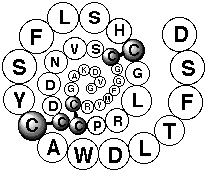- HOME
- New Product and Technology
- SNX-482
SNX-482
Class E (R-type) Ca2+ Channel Blocker!
Voltage-dependent Ca2+ channels in neuronal cell bodies are classified as L, N, P/Q, R and T-types. These channel subtypes have distinct physiological functions including neurotransmitter release. Molecular cloning has clarified the α1 subunit sequence of each channel. The α1 subunit has a specific role of eliciting activity in an individual channel. Nonetheless, selective blockers for these channel subtypes are required for defining specific channels involved in each activity. The blockers for L, N, and P/Q-types have contributed remarkably as biochemical probes in distinguishing channel subtypes. For R-type Ca2+ channel subtype, ω-agatoxin IIIA shows blocking activity, even though its selectivity is rather low: this peptide binds to all of the high voltage-activated channels including L, N, and P/Q subtypes [J. Biol.Chem., 275, 21309 (2000)]. Discovery of the R-type (or class α1E) selective blocker, which is called “SNX-482“, did not occur until 1998.
SNX-482 was isolated from the venom of the African tarantula, Hysterocrates gigas  and identified as a 41 amino acid residue peptide with 3 disulfide linkages (1-4, 2-5 and 3-6 arrangement) [Biochemistry, 37, 15353 (1998), Peptides 1998, 748 (1999)] This peptide blocks the class E Ca2+ channel (IC50=15-30 nM) and R-type Ca2+ current in the neurohypophysial nerve endings at 40 nM concentration. R-type (class E) Ca2+ channel blocking activity is highly selective: no effect is observed on K+ and Na+ currents, and L, P/Q and T-type Ca2+ currents. N-type Ca2+ current is only weakly blocked 30-50% at 300-500 nM. Regionally, different sensitivity of R-type current to SNX-482 is observed: no significant effect on R-type current occurs in preparations of the neuronal cell body, retinal ganglion cells and hippocampal pyramidal cells.
and identified as a 41 amino acid residue peptide with 3 disulfide linkages (1-4, 2-5 and 3-6 arrangement) [Biochemistry, 37, 15353 (1998), Peptides 1998, 748 (1999)] This peptide blocks the class E Ca2+ channel (IC50=15-30 nM) and R-type Ca2+ current in the neurohypophysial nerve endings at 40 nM concentration. R-type (class E) Ca2+ channel blocking activity is highly selective: no effect is observed on K+ and Na+ currents, and L, P/Q and T-type Ca2+ currents. N-type Ca2+ current is only weakly blocked 30-50% at 300-500 nM. Regionally, different sensitivity of R-type current to SNX-482 is observed: no significant effect on R-type current occurs in preparations of the neuronal cell body, retinal ganglion cells and hippocampal pyramidal cells.
Using SNX-482, three α1E- Ca2+ subunits with distinct pharmacological properties are recognized in cerebellar R-type Ca2+ channels [J. Neurosci., 20, 171 (2000)]. Similarly, it has been shown that secretion of oxytocin, but not vasopressin, is regulated by R-type Ca2+ current in neurohypophysial terminals [J. Neurosci., 19, 9235 (1999)].
Now, it appears that the time has come to start detailed analysis of R-type (or class E) Ca2+ channels.
| Code | Compound | Package |
| 4363-s | SNX-482 | 0.1 mg vial |
Peptidergic Blocker for L, N, P, and Q-type Ca2+-Channel
| Code | Blocker | Selectivity | Package |
| 4255-s | Calciseptin | L-type | 0.1 mg vial |
| 4310-s | Calcicludine | L-type | 0.1 mg vial |
| 4161-v | ω-Conotoxin GVIA | N-Type | 0.5 mg vial |
| 4289-v | ω-Conotoxin MVIIA | N-Type | 0.5 mg vial |
| 4284-v | ω-Conotoxin SVIB | N-Type | 0.5 mg vial |
| 4256-s | ω-Agatoxin IVA | P-Type | 0.1 mg vial |
| 4294-s | ω-Agatoxin TK | P-Type | 0.1 mg vial |
| 4283-v | ω-Conotoxin MVIIC | P/Q-Type | 0.5 mg vial |

